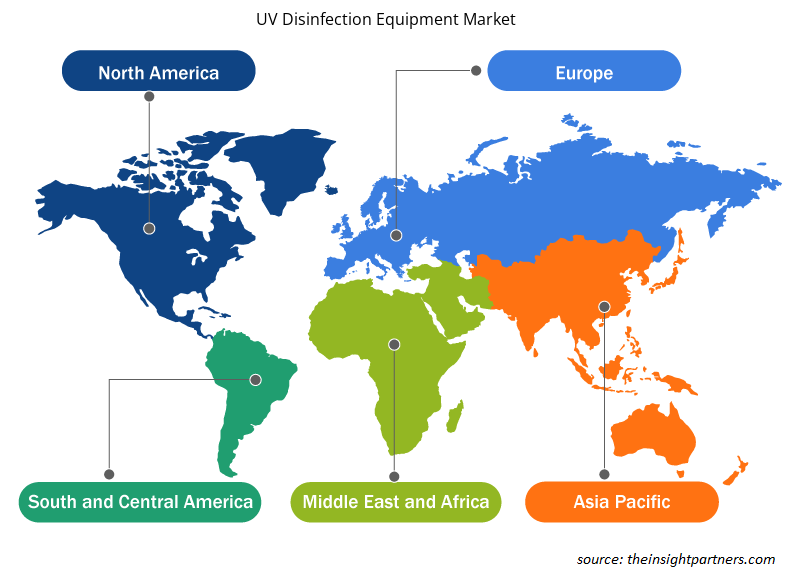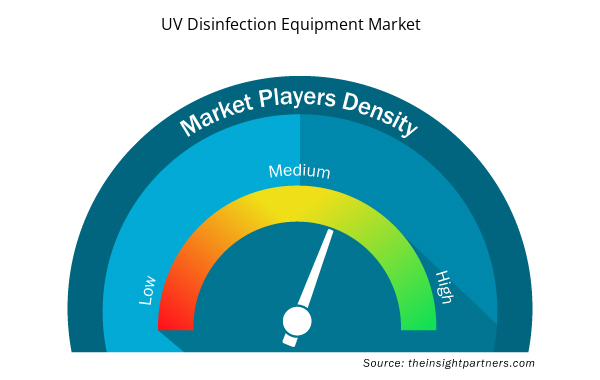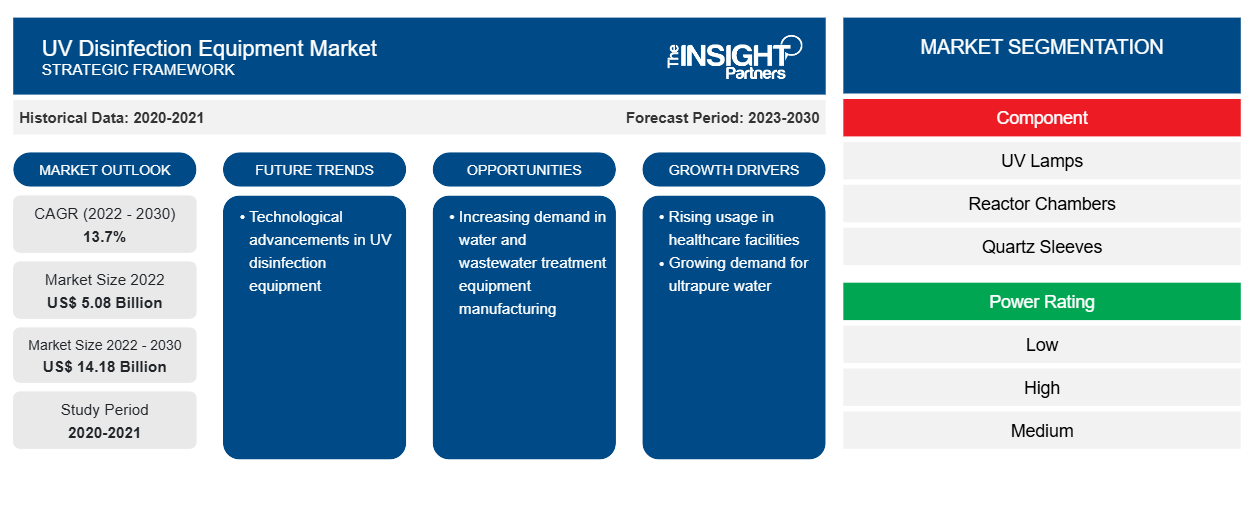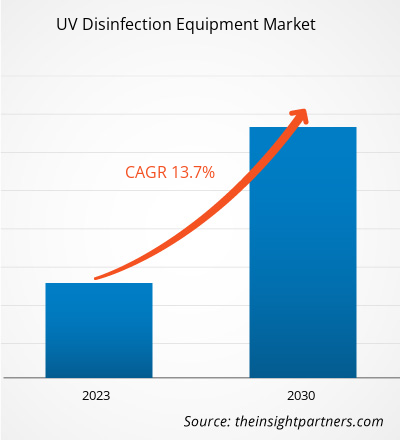[研究报告] 2022 年紫外线消毒设备市场价值为 50.8 亿美元,预计到 2030 年将达到 141.8 亿美元;预计 2023-2030 年期间的复合年增长率为 13.7%。
紫外线消毒设备市场分析师观点:
北美的紫外线 (UV) 消毒设备市场分为美国、加拿大和墨西哥。自 1970 年代初以来,清洁水一直是全国关注的问题。美国国会于 1972 年通过了《联邦水污染控制法》(通常称为《清洁水法》),以保护该国的水域。根据这项法规,美国环境保护署 (EPA) 和类似的州机构被授权监管危害国家水资源的活动。《联邦水污染控制法》制定了一项全面的国家水战略和一项消除向通航水域排放污染物的国家目标。因此,政府试图采用技术先进、无化学药品和环境友好的消毒设备,这有助于北美紫外线消毒设备市场的增长。此外,北美各国政府正在投资努力促进其制造业。2021 年 1 月,美国总统宣布了“美国制造”计划,重点是打造技术先进和自动化的制造业。通过这一举措,联邦政府正在对制造业企业进行投资并提供激励措施,这将推动对紫外线消毒设备的需求,以提高设施的安全性。
紫外线消毒设备市场概况:
在美国,由于 COVID-19 疫情以及人口老龄化,人们对卫生和安全问题的担忧日益增加,尤其是在医疗保健和食品行业,这是推动医疗保健行业增长的关键因素。根据美国疾病控制与预防中心 (CDC) 2019 年的估计,医院相关感染 (HAI) 每年造成约 170 万例感染和 99,000 例相关死亡。美国政府正在采取多项措施来对抗传染病的传播。据 CDC 称,截至 2019 年 11 月,已有 36 个州和哥伦比亚特区 (DC) 通过了有关预防和报告 HAI 的法律。因此,整个地区对紫外线消毒设备的需求正在增加。此外,美国污染水平的上升和空气传播疾病的流行率的上升提高了消费者的意识,增加了紫外线消毒设备市场对空气净化的需求。
定制此报告以满足您的需求
您可以免费定制任何报告,包括本报告的部分内容、国家级分析、Excel 数据包,以及为初创企业和大学提供优惠和折扣
- 获取此报告的关键市场趋势。这个免费样品将包括数据分析,从市场趋势到估计和预测。
紫外线消毒设备市场驱动因素:
超纯水需求增长推动紫外线消毒设备市场增长
超纯水仅含有 H2O 分子以及平衡的氢和羟基 (H+ 和 OH-) 离子;经过严格处理以满足严格的要求并消除上述离子以外的离子。紫外线消毒系统用于降低总有机碳 (TOC) 水平、消除氯/氯胺和臭氧并降低水中的微生物负荷。基于紫外线的消毒系统因其效率、可靠性和运行时间短而成为获得超纯水的首选。超纯水在制药、太阳能光伏、半导体器件制造和发电行业具有重要应用。它用于产生蒸汽以驱动电力工业中的蒸汽涡轮机。
超纯水在半导体工厂中用作清洁剂,以防止微芯片故障。根据半导体行业协会 (SIA) 的数据,2023 年 4 月全球半导体行业销售额与 2023 年 3 月相比增长了 0.3%。因此,随着半导体行业的进步,对超纯水的需求也在增加。因此,不同行业对超纯水的需求激增有利于紫外线消毒设备市场的增长。
紫外线消毒设备市场报告预测和分部分析:
在应用方面,紫外线消毒设备市场研究报告分为水消毒、空气消毒和表面消毒。水消毒部分在 2022 年占据了紫外线消毒设备市场规模的主导地位,预计将持续到 2030 年。紫外线消毒设备由于其优于其他方法的优势,在水消毒系统中的应用越来越广泛。紫外线消毒是一种无化学过程,用于杀死微生物,包括细菌、病毒和原生动物。它是一种高效的消毒方法,不会产生任何有害的副产品。各种紫外线消毒设备制造商都在提供水消毒产品。例如,2023 年 2 月,丰田合成株式会社推出了一款紧凑型紫外线 C (UV-C) LED 净水装置。UV-C LED 可有效消除细菌和病毒。UV-C LED 净水装置配备了“WOSH”——一种水循环便携式盥洗台。该装置利用内部流动的水来冷却 LED 发出的热量。这减少了散热部件的数量,使设备更加紧凑。 以上因素因此促进了紫外线消毒设备市场的增长。
紫外线消毒设备市场区域分析:
据加拿大政府称,由于工业化进程的迅速发展,废水是加拿大地表水污染的最大来源。在加拿大,人口的增长增加了对清洁、安全饮用水的需求。大多数废水系统 由市政当局拥有和运营,市政当局负责管理废水的收集、处理和排放。政府还管理 1999 年《加拿大环境保护法》(CEPA 1999)所列物质带来的风险。此外,加拿大环境部长理事会于 2020 年 8 月检索了《市政废水排放战略》。检索到的战略倾向于在所有废水处理后进行审查。因此,对废水处理的认识要求使用紫外线消毒设备,并增加了该国的紫外线消毒设备市场规模。
紫外线消毒设备市场公司/关键参与者分析:
紫外线消毒设备市场已根据 Xylem Inc、Trojan Technologies Group ULC、Halma Plc、Kuraray Co Ltd、Atlantic Ultraviolet Corp、Advanced UV Inc、American Ultraviolet Inc、Atlantium Technologies Ltd、Dr. Honle AG 和 Evergreen UV LLC 等公司的表现进行了分析。
紫外线消毒设备市场区域洞察
Insight Partners 的分析师已详尽解释了预测期内影响紫外线消毒设备市场的区域趋势和因素。本节还讨论了北美、欧洲、亚太地区、中东和非洲以及南美和中美洲的紫外线消毒设备市场细分和地理位置。

- 获取紫外线消毒设备市场的区域特定数据
紫外线消毒设备市场报告范围
| 报告属性 | 细节 |
|---|---|
| 2022 年市场规模 | 50.8亿美元 |
| 2030 年的市场规模 | 141.8亿美元 |
| 全球复合年增长率(2022 - 2030 年) | 13.7% |
| 史料 | 2020-2021 |
| 预测期 | 2023-2030 |
| 涵盖的领域 | 按组件
|
| 覆盖地区和国家 | 北美
|
| 市场领导者和主要公司简介 |
|
紫外线消毒设备市场参与者密度:了解其对业务动态的影响
紫外线消毒设备市场正在快速增长,这得益于终端用户需求的不断增长,而这些需求又源于消费者偏好的不断变化、技术进步以及对产品优势的认识不断提高等因素。随着需求的增加,企业正在扩大其产品范围,进行创新以满足消费者的需求,并利用新兴趋势,从而进一步推动市场增长。
市场参与者密度是指在特定市场或行业内运营的企业或公司的分布情况。它表明在给定市场空间中,相对于其规模或总市场价值,有多少竞争对手(市场参与者)存在。
在紫外线消毒设备市场运营的主要公司有:
- 赛莱默公司
- 特洛伊技术集团
- 豪迈集团
- 可乐丽株式会社
- 大西洋紫外线公司
免责声明:上面列出的公司没有按照任何特定顺序排列。

- 了解紫外线消毒设备市场主要参与者概况
紫外线消毒设备市场最新发展:
紫外线消毒设备市场中的公司普遍采用并购等无机和有机战略。以下列出了一些近期的关键市场发展。
- 2023 年,Xylem Inc 以全股票交易方式收购了 Evoqua Water Technologies Corp,交易价值约为 75 亿美元。此次合并将打造全球最先进的能力平台,以应对客户和社区面临的关键水资源挑战。
- 2019 年,赛莱默推出了一款新型紫外线消毒系统,为海水和其他恶劣水质条件下的水产养殖场提供解决方案。在 Aqua Nor 2019 大会上亮相的新型 Wedeco Action PE 紫外线 (UV) 消毒系统旨在实现超过 99.99% 的消毒率。
- 2019 年,Atlantic Ultraviolet Corporation (AUV) 在 Ultraviolet.com 上为遇到沸水警报的个人推出了一个特定应用页面。此页面是 Ultraviolet.com 上一系列新特定应用页面中的第四部分,提供有关在特定应用中使用 UV-C 进行无化学消毒的信息。
- 2018 年,可乐丽株式会社完成了对卡尔冈炭素公司的收购。卡尔冈炭素将与可乐丽的碳材料业务部门一起被纳入可乐丽功能材料公司。功能材料公司包括甲基丙烯酸酯部门和医疗部门。
- 历史分析(2 年)、基准年、预测(7 年)及复合年增长率
- PEST 和 SWOT 分析
- 市场规模价值/数量 - 全球、区域、国家
- 行业和竞争格局
- Excel 数据集


- Electronic Signature Software Market
- Europe Industrial Chillers Market
- Lymphedema Treatment Market
- Joint Pain Injection Market
- Europe Tortilla Market
- Precast Concrete Market
- Helicopters Market
- Airport Runway FOD Detection Systems Market
- Grant Management Software Market
- Single-Use Negative Pressure Wound Therapy Devices Market

Report Coverage
Revenue forecast, Company Analysis, Industry landscape, Growth factors, and Trends

Segment Covered
This text is related
to segments covered.

Regional Scope
North America, Europe, Asia Pacific, Middle East & Africa, South & Central America

Country Scope
This text is related
to country scope.
常见问题
Europe is anticipated to grow with the highest CAGR over the forecast period.
The key players, holding majority shares, in UV disinfection equipment market includes Xylem Inc, Trojan Technologies Group ULC, Halma Plc, Kuraray Co Ltd, and Atlantic Ultraviolet Corp.
The UV disinfection equipment market is expected to reach US$ 14.18 billion by 2030.
The incremental growth, expected to be recorded for the UV disinfection equipment market during the forecast period, is US$ 9.09 billion.
The increasing uses of the UV disinfection system in the healthcare, and growing demand for the ultrapure water are the major factors that propel the UV disinfection equipment market growth.
The global UV disinfection equipment market was estimated to be USD 5.billion in 2022 and is expected to grow at a CAGR of 13.7 %, during the forecast period 2022 - 2030.
The technological advancements in UV disinfection equipment is the future trends for the UV disinfection equipment market.
Trends and growth analysis reports related to Electronics and Semiconductor : READ MORE..
The List of Companies - UV Disinfection Equipment Market
- Xylem Inc
- Trojan Technologies Group ULC
- Halma Plc
- Kuraray Co Ltd
- Atlantic Ultraviolet Corp
- Advanced UV Inc
- American Ultraviolet Inc
- Atlantium Technologies Ltd
- Dr. Honle AG
- Evergreen UV LLC
The Insight Partners performs research in 4 major stages: Data Collection & Secondary Research, Primary Research, Data Analysis and Data Triangulation & Final Review.
- Data Collection and Secondary Research:
As a market research and consulting firm operating from a decade, we have published and advised several client across the globe. First step for any study will start with an assessment of currently available data and insights from existing reports. Further, historical and current market information is collected from Investor Presentations, Annual Reports, SEC Filings, etc., and other information related to company’s performance and market positioning are gathered from Paid Databases (Factiva, Hoovers, and Reuters) and various other publications available in public domain.
Several associations trade associates, technical forums, institutes, societies and organization are accessed to gain technical as well as market related insights through their publications such as research papers, blogs and press releases related to the studies are referred to get cues about the market. Further, white papers, journals, magazines, and other news articles published in last 3 years are scrutinized and analyzed to understand the current market trends.
- Primary Research:
The primarily interview analysis comprise of data obtained from industry participants interview and answers to survey questions gathered by in-house primary team.
For primary research, interviews are conducted with industry experts/CEOs/Marketing Managers/VPs/Subject Matter Experts from both demand and supply side to get a 360-degree view of the market. The primary team conducts several interviews based on the complexity of the markets to understand the various market trends and dynamics which makes research more credible and precise.
A typical research interview fulfils the following functions:
- Provides first-hand information on the market size, market trends, growth trends, competitive landscape, and outlook
- Validates and strengthens in-house secondary research findings
- Develops the analysis team’s expertise and market understanding
Primary research involves email interactions and telephone interviews for each market, category, segment, and sub-segment across geographies. The participants who typically take part in such a process include, but are not limited to:
- Industry participants: VPs, business development managers, market intelligence managers and national sales managers
- Outside experts: Valuation experts, research analysts and key opinion leaders specializing in the electronics and semiconductor industry.
Below is the breakup of our primary respondents by company, designation, and region:

Once we receive the confirmation from primary research sources or primary respondents, we finalize the base year market estimation and forecast the data as per the macroeconomic and microeconomic factors assessed during data collection.
- Data Analysis:
Once data is validated through both secondary as well as primary respondents, we finalize the market estimations by hypothesis formulation and factor analysis at regional and country level.
- Macro-Economic Factor Analysis:
We analyse macroeconomic indicators such the gross domestic product (GDP), increase in the demand for goods and services across industries, technological advancement, regional economic growth, governmental policies, the influence of COVID-19, PEST analysis, and other aspects. This analysis aids in setting benchmarks for various nations/regions and approximating market splits. Additionally, the general trend of the aforementioned components aid in determining the market's development possibilities.
- Country Level Data:
Various factors that are especially aligned to the country are taken into account to determine the market size for a certain area and country, including the presence of vendors, such as headquarters and offices, the country's GDP, demand patterns, and industry growth. To comprehend the market dynamics for the nation, a number of growth variables, inhibitors, application areas, and current market trends are researched. The aforementioned elements aid in determining the country's overall market's growth potential.
- Company Profile:
The “Table of Contents” is formulated by listing and analyzing more than 25 - 30 companies operating in the market ecosystem across geographies. However, we profile only 10 companies as a standard practice in our syndicate reports. These 10 companies comprise leading, emerging, and regional players. Nonetheless, our analysis is not restricted to the 10 listed companies, we also analyze other companies present in the market to develop a holistic view and understand the prevailing trends. The “Company Profiles” section in the report covers key facts, business description, products & services, financial information, SWOT analysis, and key developments. The financial information presented is extracted from the annual reports and official documents of the publicly listed companies. Upon collecting the information for the sections of respective companies, we verify them via various primary sources and then compile the data in respective company profiles. The company level information helps us in deriving the base number as well as in forecasting the market size.
- Developing Base Number:
Aggregation of sales statistics (2020-2022) and macro-economic factor, and other secondary and primary research insights are utilized to arrive at base number and related market shares for 2022. The data gaps are identified in this step and relevant market data is analyzed, collected from paid primary interviews or databases. On finalizing the base year market size, forecasts are developed on the basis of macro-economic, industry and market growth factors and company level analysis.
- Data Triangulation and Final Review:
The market findings and base year market size calculations are validated from supply as well as demand side. Demand side validations are based on macro-economic factor analysis and benchmarks for respective regions and countries. In case of supply side validations, revenues of major companies are estimated (in case not available) based on industry benchmark, approximate number of employees, product portfolio, and primary interviews revenues are gathered. Further revenue from target product/service segment is assessed to avoid overshooting of market statistics. In case of heavy deviations between supply and demand side values, all thes steps are repeated to achieve synchronization.
We follow an iterative model, wherein we share our research findings with Subject Matter Experts (SME’s) and Key Opinion Leaders (KOLs) until consensus view of the market is not formulated – this model negates any drastic deviation in the opinions of experts. Only validated and universally acceptable research findings are quoted in our reports.
We have important check points that we use to validate our research findings – which we call – data triangulation, where we validate the information, we generate from secondary sources with primary interviews and then we re-validate with our internal data bases and Subject matter experts. This comprehensive model enables us to deliver high quality, reliable data in shortest possible time.


 获取此报告的免费样本
获取此报告的免费样本